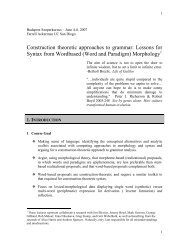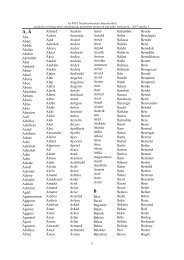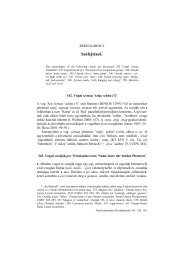Nyelvtudományi közlemények 91. kötet (1990)
Nyelvtudományi közlemények 91. kötet (1990)
Nyelvtudományi közlemények 91. kötet (1990)
Sie wollen auch ein ePaper? Erhöhen Sie die Reichweite Ihrer Titel.
YUMPU macht aus Druck-PDFs automatisch weboptimierte ePaper, die Google liebt.
104 JUHA JANHUNEN<br />
problem: the Komi word was borrowed by the Nenets with the specialized<br />
meaning 'sheepskin', for sheepskins represented the only commercially important<br />
type of skin that the Komi had and the Nenets did not have. It<br />
can be concluded that the first information about sheep breeding reached<br />
the Samoyed tundras not through the Russians but through the Komi. This<br />
is, of course, completely congruous with what is otherwise known of the<br />
cultural history of the region.<br />
As to the chronology of the borrowing, the wide distribution of the word<br />
in the Tundra Nenets dialects as well as the semantic change from 'sheepskin'<br />
to 'sheep' suggest that /xu/ may well be one of the earliest items of<br />
Komi vocabulary to have penetrated intő Nenets. In fact, the borrowing<br />
most probably took place during the initial stages of the Izhma Komi expansion.<br />
It may be added that the Komi word /ku/ was once much later,<br />
in the 19th Century, recorded from a bilingual Tundra Nenets speaker as a<br />
direct citation loan in the meaning 'leather' (Schrenk/Swv. 72, cf. Türkin<br />
1985. 195). By that time, the relationship between Komi /ku/ and Nenets<br />
/xu/ had probably become quite obscure even in the minds of bilingual<br />
speakers of both languages.<br />
From the point of view of absolute chronology, it is relevant to note that<br />
the Nenets stem /xu/ was already recorded in its modem meaning in the<br />
17th and 18th centuries. The early sources know the word only as a deminutive<br />
derivative: Goewoetza 'Schaep' ~ Clioewoctza' 'een Pels' (Witsen/SWv.<br />
6-7), e nycmo3epcKOM oup. xymi,h 'öapan' (LTOVC 2.62), /xu(a)Ca/ (it<br />
seems futile to speculate about the vocalism of the stem, as reflected in<br />
the inadéquate transcription used in the old sources). Incidentally, the same<br />
derivative is still dialectally preserved today, although it may have lost its<br />
specific référence to the sheep or sheepskins: 3an. xyv,s{ /xuCa/ 'o^eiuio H3<br />
mKyp' (NRS 787). There is also one early occurrence of the phrase /xuhgoba/,<br />
written down in the 18th Century, but this was allegedly recorded<br />
in the Enets language: Manra3eíícKaro oKpyra xynxo6a '6apaH'. It remains<br />
an archaeographical task to investigate whetlier the information really<br />
cornes form Enets, in which case the Nenets phrase would have been présent<br />
in Enets as a loanword, or whetlier it is just a question of misplacement of<br />
the lexical material (the phrase is also certainly misspelled in the source).<br />
As a diachronic curiosity, it may be mentioned that the Komi word /ku/<br />
is of Common Uralic origin and ultimately identical with Nenets /xoba/<br />
(KESK 143, UKS 252). Thus, the Nenets phrase /xuh-goba/ represents a<br />
very special kind of figura etymologica, with the two components united<br />
after several millenia of séparation.<br />
The cultural conclusion of the etymological resuit presented above is<br />
that the Tundra Nenets originally became familiär with the sheep as the<br />
Nyelvtudományi Közlemények <strong>91.</strong> <strong>1990</strong>.


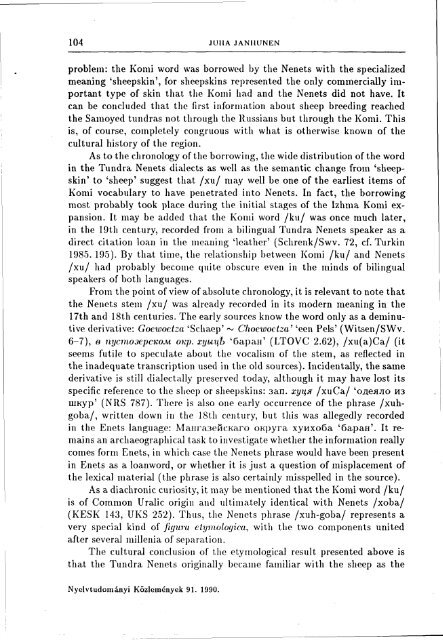

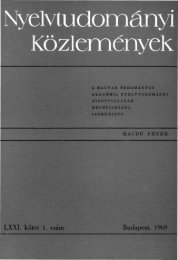

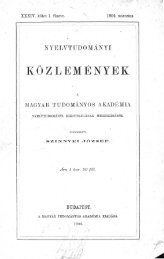
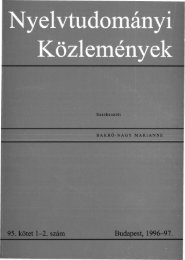
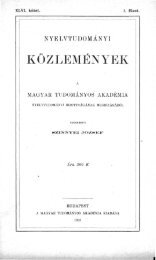
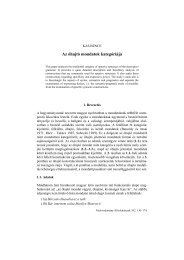
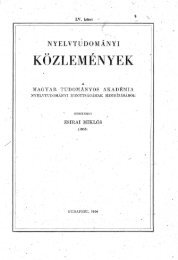
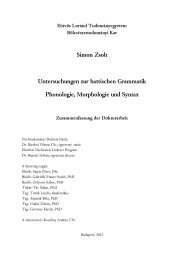
![Gósy Mária: A [p, t, k] mássalhangzók zöngekezdési ideje Bevezetés ...](https://img.yumpu.com/15682849/1/190x245/gosy-maria-a-p-t-k-massalhangzok-zongekezdesi-ideje-bevezetes-.jpg?quality=85)

